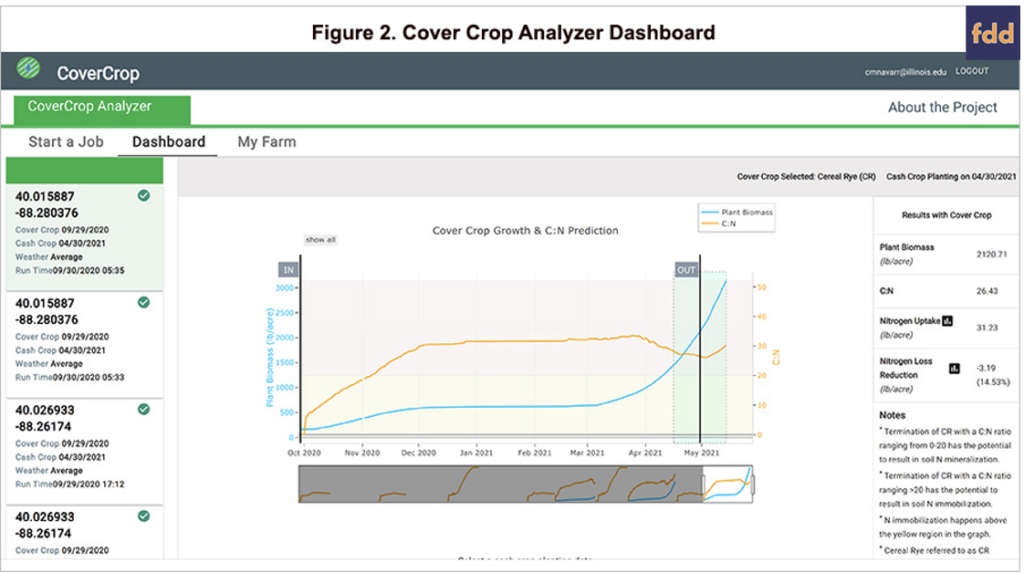On October 1, 2020 the Gardner Agricultural Policy program, the farmdoc project, and the National Center for Supercomputing Applications (NCSA) officially launched the Cover Crop Analyzer, which was a decision support tool designed to help Illinois farmers manage cover crops in their fields. This project was funded and brought to you by the Illinois Nutrient Research and Education Council (NREC).
Background
- Nitrogen (nitrate) is one of the major nonpoint source pollutants in Illinois and the Midwest.
- The loss of nutrients into waterways can have potential implications for water quality not only locally, but by way of hypoxia in the Gulf of Mexico
- “The Science Assessment to the Illinois Nutrient Loss Reduction Strategy (INLRS) and substantial research indicates that fertilizer applications on tile-drained corn and soybean fields are a major contributor to nutrient loads, with fall-applied fertilizers being the most susceptible to loss (INLRS Science Assessment, 2015; Kladivko et al., 2004; Fausey et al., 1995; Keeney and Duluca, 1993; Randall and Vetsch, 2005).”
Cover Crops
- “One method of reducing nutrient losses from fall application is by use of winter cover crops in place of a conventional, bare fallow method which reduces carbon and soil organic matter stocks and leaves unused additions of inorganic nitrogen more vulnerable to losses (Drinkwater and Snapp, 2007; Kaspar et al., 2007; Lacey and Armstrong, 2014; Lacey and Armstrong, 2015; Malone et al., 2014; Snapp et al., 2005).”
- “Cover crops can be an effective in-field strategy for reducing nutrient loss and helping achieve the INLRS, but farmer adoption has to-date been a significant challenge (Cover Crop Survey, 2016).”
Why do we need a tool?
- Cover crops can add risk, management complexity, and cost to the operation; therefore, this web-based tool was created to provide farmers (and researchers) a way to help with cover crop adoption and management decisions.
- “The cover crop tool uses the Decision Support System for Agrotechnology Transfer (DSSAT), which is an open-source modeling program for dynamic crop growth simulation for over 42 crops (Hoogenboom et al., 2019a; Hoogenboom et al., 2019b; Jones et al., 2003).”
- “The tool uses publicly available weather data from the Illinois State Water Survey and soils data from USDA’s SSURGO soil survey database for each field in Illinois using the Farm Service Agency Common Land Units (2008) obtained via Ag-Analytics.Org (Woodard 2016a; Woodard 2016b).”
- The tool also uses cropping history from USDA’s cropland data layer and a default set of management practices (seed population, fertilizer, etc.) developed by the project team based on historic regional data for Illinois.

How does it work?
- A farmer can simulate the results of a cover crop growing in their field, based on CLU, SSURGO, and weather.
- If a farmer knows the approximate planting date of his cash crop, he can then select two different dates within a two-week window and compare potential biomass in the field, C:N ration in that biomass, nitrogen uptake, and nitrogen loss reduction.
- As a bonus, farmers can provide additional field information such as cropping history and management programs to fine tune the results even further.
How can you help?
- Since the launch of this tool, many improvements have been made that include additional functionality, weather data features and modeling, as well as the addition of other cover crops.
- As more and more make the decision to adopt cover crops in their operation, check out this web-based tool to bring the power of demonstration and translation of agricultural research into your hands and to the fields on your farm.
Citation: Coppess, J., C. Navarro, S. Satheesan, V. Gowtham Naraharisetty, R. Bhattarai, S. Armstrong and R. Gupta. “Introducing the Cover Crop Decision Support Tool.” farmdoc daily (10):176, Department of Agricultural and Consumer Economics, University of Illinois at Urbana-Champaign, October 1, 2020.Permalink




 and then
and then